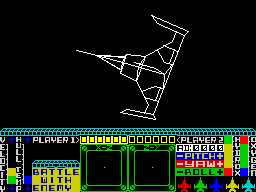Starion for the ZX Spectrum was a 3D wireframe (or vector graphics) arcade game released by Melbourne House in May of 1985.
Melbourne House released a variety of well known (and very good) games for the ZX Spectrum such as Way of the Exploding Fist, The Hobbit and Red Hawk).
Starion was yet another quality arcade game from the talented studio.

The whole back story of Starion was that the year was the (then futuristic!) 2010. You (as the slightly dorky sounding 'Starion') had graduated from the space academy. I can't imagine a 'Space Academy' opening up sometime this year... Anyway - even though Starion was a green around the gills rookie, he had been given the one and only existing 'timeship'.
Using this timeship you had to repair the damage that had been inflicted upon the space-time continuum by a bunch of evil aliens (no not Doc Brown or Marty McFly).
So off you blasted into space and time to kill any enemy aliens crossing your path and righting whatever wrongs they had already perpetrated.
The first part of this classic game was to patrol the outer regions of space and intercept and destroy any alien ships you happened to find. As you attacked and destroyed each enemy ship it would reform as a letter of the English alphabet.
This letter had to be collected and stowed aboard your ship. When you had collected the required number of letters (after destroying a certain amount of enemies), you were asked to unscramble what you had and rearrange them to make a well known word that fitted some important period in history.
Once unscrambled it was time to locate the entrance to a time warp and fly right into it, whereupon a time grid was displayed. Each grid had nine time zones and you had to decide which of the time zones contained the historical event that your cargo letters fitted (were it C-R-E-D-I-T you may have thought of the hopeless government in the late 2000's ;-))
If the cargo you recovered solved the correct 'puzzle' then you were rewarded with fresh fuel and oxygen which allowed you to fly off and solve the next time zone. If your cargo of letters did not fit the puzzle then you had to destroy more enemy ships within that zone which would give you enough fuel to escape and move to another zone to try again.
All in all, Starion had 243 time zones to visit and solve - plenty to do before completing it!
The graphical style in Starion was the gaming classic 'cockpit view', with instrument panels displaying details on speed, hull temperature, enemy location, pitch, role, yaw, fuel and oxygen levels.
Scanners showed the location of other objects, (both horizontally and vertically), such as ships, mines, missiles and even space debris. Above the scanners the year of the current time zone was shown which was vital when trying to solve the time zone problems.
The hull temperature was also vital to the game because the outside temperature increased as you travelled more quickly and also increased from excessive lazer fire. The hull could also be destroyed by direct hits from enemy weapons or collision with objects floating around in space (as you would imagine).
In a twist for these types of games the general debris could not be destroyed and you had to avoid it.
The top two thirds of the screen showed the 3D realm of space, with any objects, ships etc that were in visual range - all animated with nice fast and smooth moving vector graphics.
Points were awarded in accordance with the speed at which the player completed each stage of the game - the faster you were the more you scored. You could acheive promotions depending on the number of time zones that you had solved.
If you fancied easing the loneliness of outer space, a friend could join in for a bit of 2 player Starion action.
On Release:
Starion was a change in style for Melbourne House - and they proved that they could turn their hand to developing all types of games. The Speccy gamers bible Crash magazine awarded it an overall score of 94%, and gamers enjoyed the good blend of 3D arcade action and puzzle solving, making Starion stand out from other 3D games that were already around. The game went on to be a big hit and sold plenty of copies. The vector graphics were well done - fast moving and smooth, and probably would not be surpassed until the release of Starsrike II.
The test of time:
Here in the land of ZX Spectrum games we reckon that Starion is still pretty fun to play. The overall game is pretty simple by todays standards and can get a bit repetitive, but the vector graphics move nicely and the action is fast and frenetic. For a quick blast of classic game action, Starion is still a good choice. Oh and I doff my cap to David Webb for squeezing so much into 48K of memory.
So, stick on a bit of bad sci-fi and give Starion a go. You'll T-H-A-N-K us for it!
We recommend getting hold of the real Sinclair hardware but if not then download a ZX Spectrum emulator and download Starion for the ZX Spectrum. Alternatively you could try and play it online.
GENRE: 3D Arcade Game
RELEASE DATE: May of 1985
RELEASED BY: Melbourne House
DEVELOPER(S): David Webb
PRICE: £7.95 - UK
Our rookie blows up a few evil aliens and collects some letters in classic arcade action -Starion:
Classic Games, Arcade Games and ZX Spectrum Games
{ 0 komentar... Views All / Send Comment! }
Post a Comment